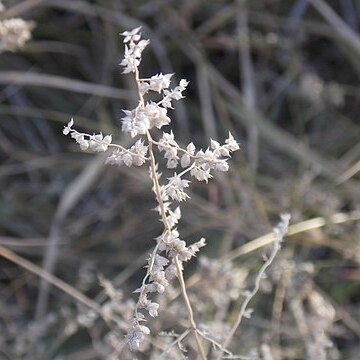Spikelets 3–4 × 2.5–3 mm, ovate to oblong-ovate, strongly laterally compressed, 6–12(14)-flowered, the florets disarticulating from the apex downwards, the rhachilla fragile; glumes subequal, 1.5–2 mm long, reaching to and sometimes exceeding the apex of the adjacent lemmas, keeled, lanceolate in profile, glabrous on the flanks, gland-dotted on the nerves, acuminate at the apex; lemmas c. 2 mm long, keeled, ovate in profile, membranous with prominent lateral nerves, diverging from the rhachilla at a wide angle but those in opposite rows imbricate and concealing the rhachilla, greyish-green, sometimes tinged with purple, glabrous on the flanks, gland-dotted on the keel and lateral nerves, subacute at the apex; palea glabrous on the flanks, the keels slender, scabrid above, broadly winged in the lower half, the upper margin of the wing sometimes truncate but usually concave (the wing thus auriculate); anthers 3, c. 0.6 mm long.
Perennial; up to 0.9 m high; tufted; erect or geniculate. Culms with basal sheaths glabrous or long-hairy at extreme base only. Leaf blades up to 500 x 6 mm. Flowers: panicle sparsely branched; spikelets densely congested and secund on branches; pedicels short and stout; spikelets 2-6 x 2.2-3.5 mm; spikelet rachilla very fragile; easily disarticulating between florets from apex downwards; lower glume acuminate; palea acute; keels scaberulous; with lower portion very broad and projecting from upper portion; top of broad portion ends in deep notch or tooth; lemma keels and lateral nerves gland dotted; anthers 3; 0.5-0.7 mm long; caryopsis elliptic.
Perennial, tufted (erect or geniculate), up to 0.9 m high. Leaf blades up to 500 mm long, up to 6 mm wide. Basal sheaths glabrous or long-hairy at extreme base only. Spikelets 2-6 mm long, 2.2-3.5 mm wide. Inflorescence sparsely branched, spikelets densely congested and secund on branches, pedicels short and stout; spikelet rhachilla very fragile, easily disarticulating between florets from apex downwards; lower glume acuminate; palea acute, keels scaberulous, with lower portion very broad and projecting from upper portion, top of broad portion ends in deep notch or tooth; anthers 3, 0.5-0.7 mm long. Caryopsis elliptic.
Caespitose perennial with short oblique rhizome; culms up to 60(85) cm tall, erect or ascending, usually unbranched but sometimes branched below, glabrous at the nodes, often with an annular gland below the nodes; basal leaf sheaths glabrous or thinly pilose, chartaceous, terete, with scattered glandular pits, persistent; ligule a line of hairs; leaf laminas (2.5)5–15(20) cm × (1)2–5 mm, linear, flat or involute, glabrous or scattered-pilose (the upper surface also asperulous), with or without glandular pits in the nerves beneath.
Panicle 4–19 cm long, lanceolate to narrowly ovate, the spikelets densely clustered on very short pedicels on stubby side branches, the primary branches not in whorls, terminating in a fertile spikelet, glabrous in the axils, the rhachis with an annular gland beneath each branch and the branches with crateriform glands.
Caryopsis c. 1 mm long, elliptic to oblong-elliptic.

